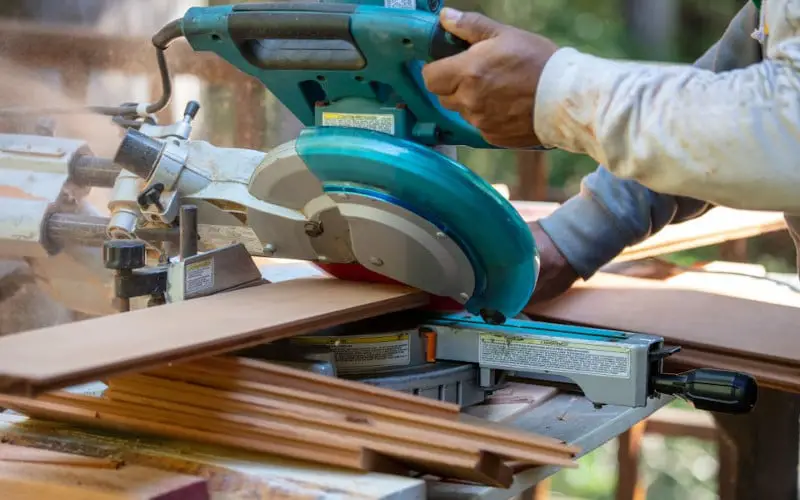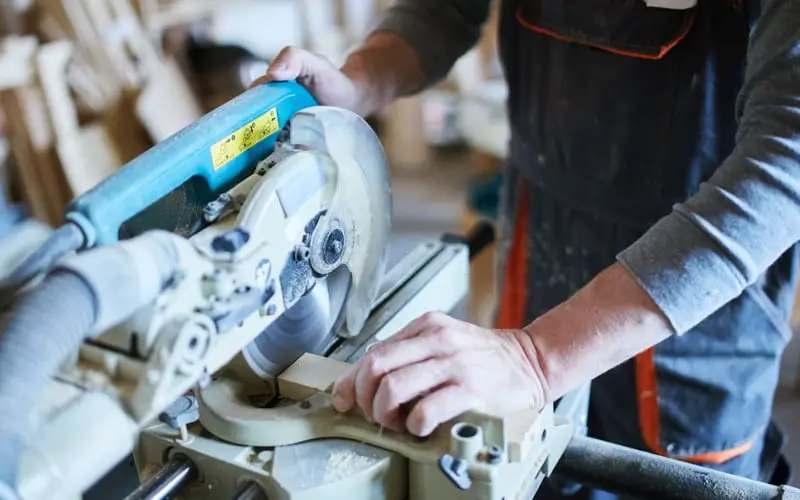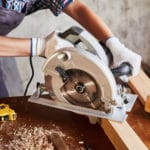Woodworking tools are a vital part of any woodworker’s toolbox, and there is no shortage of options when it comes to the right saw for your needs. The radial arm saw and the miter saw constitute two very different types of saws that have their unique advantages and disadvantages.
These revolutionary tools can be used in many ways but they both excel at one thing: cutting wood.
The radial arm saw has been around since the early 1900s but was never really taken seriously until recently. However, with its ability to make precise cuts on almost any type of material, this saw can be an invaluable addition to your shop.
The miter saw is another versatile power tool in the workshop that allows you to make quick and accurate cuts on all sorts of materials. It has become more popular over the years as technology improves and people start using them more often.
In this post, we will compare these two important tools by looking at some of the differences between each other. We will also look at how you can use each of them effectively to get the most out of them.
What is a Radial Arm Saw?

The radial arm saw has been around since the early 1900s, and was invented by Raymond DeWalt. In his patent application filed in 1925, he describes an electric motor with a rotating shaft attached to a circular blade. He also described how the blade could cut long pieces of wood to the desired length.
Since then, many improvements have been made to the design of the saw, although they’re currently not as popular as their brothers the miter saws.
A radial arm saw is simply a powerful tool that consists of a base unit and a rotating head mounted on top of the base unit. The rotating head contains multiple blades which cut through the workpiece. This tool is mainly used for making straight cuts on various types of wood and metal.
With a blade diameter of 12 to 22 inches, the radial arm saw is designed to give you greater control over the depth of the cut than a standard circular saw or jigsaw. It easily cuts deep through thick lumber and even large sheets of plywood without tearing up the surface.
It is possible to adjust the angle of the blade in relation to the base unit. You can also change the height of the blade from 1 inch to 4 inches. This allows you to cut pieces of wood at varying depths.
A radial arm saw is a very versatile tool that is ideal for making precision cuts on a variety of materials including plywood, hardwoods, softwoods, plastic, metal, and even glass. They are great for creating decorative designs on furniture, picture frames, doors, windows, etc.
On the offside, these saws are not portable and require an operating station, unlike the miter saw. But if you need to cut something quickly and precisely, they are definitely worth considering.
What Can A Radial Arm Saw Be Used For?
Miter saws have many uses. Here’s a list of the major uses:
- Crosscuts – Cutting across the grain of the material is quite simple with a radial arm saw. Just measure and mark the wood you want to cut (while accounting for the blade width) and then lower and align the blade before you power on the radial arm saw. Pull the saw towards you firmly and then power off the saw when the operation is complete. If you want to make sure your crosscutting is precise, you can attach a fence to the saw and position it accordingly.
- Miter cuts, bevels, and compound cuts – These cuts are more complicated but still achievable with a radial arm saw because this saw has a miter and bevel release that allows you to cut manually. Again, although it might be quite daunting, you’ll need to manually set the depth of the cut based on your preference, because the radial arm saw has no actual measurement indication on the saw itself.
- Rabbets and dadoes – Rabbet cutting involves cutting into a piece of stock to create a groove. Dado cutting involves cutting out a portion of the stock to create a recess. Both of these operations are fairly easy to do with a radial arm saw and require little skill to accomplish.
- Ripping – Radial arm saws are essentially superior to their counterpart the miter saw due to their ability to rip. Rips allow you to cut along the length of the wood rather than having to move the entire piece of stock.
What is a Miter Saw?

A miter saw rather a more recent invention than the radial arm saw. However, its popularity has grown tremendously since its introduction. It may be termed as an advancement to the radial arm saw, invented in the 1970s. The miter saw is much lighter in weight than the radial arm saw and is easier to carry around. It is also easier to operate and maneuver.
The miter saw is a motorized table saw that has been modified to accommodate the purpose of cutting miters. This tool comes in three variations: compound miter, dual compound miter, and sliding compound miter.
Available in various blade sizes, 8 to 12 inches in diameter, this saw allows you to easily cut at various degrees of angles. You can cut both straight and angled lines. With the addition of accessories, like fences and depth stops, you can adjust the angle of the cut and the height of the blae respectfully.
For enhanced safety, the miter saw has protective blade guards that protect you from accidents and act as dust collection mechanisms.
Miters are excellent options when you want to achieve maximum accuracy and repeatability.
What Can a Miter Saw Be Used For?
There are actually quite a few things that you can use a miter saw for.
Here’s a list:
- Crosscutting – Like most saws, the miter saw can be used to crosscut any type of material. But, unlike other saws, cutting across the grain using a miter is much easier, quicker, ad precise.
- Mitering – Mitering is the process of making angled cuts across the width of a piece of wood. This is precisely what the miter saw does best given its ability to pivot to various degrees and the enhanced stability due to the hinged handle and fence.
- Beveling – Beveling is the process of creating different angles on a surface. Using a miter saw, you can make a variety of bevel cuts and join two pieces of wood to produce an invisible seam.
- Compound cutting – Compound cutting is the process of cutting multiple cuts in one pass. They are a mix of the bevel cut and miter cut. A miter saw excels at this because it can perform both functions in one pass. All you need is to adjust the bevel and miter angles to desired levels before you start cutting.
Difference Between Radial Arm Saw and Miter Saw
It is important to understand the difference between the radial arm saw and the miter saw. While both are very useful tools, they have some differences. Let’s take a look.
| Radial Arm Saw | Miter Saw | |
|---|---|---|
| Cutting depth | Cuts deeper | Cuts less deep |
| Portability | Not portable | Portable |
| Ease of use | Not as easy to use | Easy to use |
| Safety | It may be dangerous if mishandled | Quite safe |
| Versatility | Can perform a variety of cuts | Limited to a few cuts |
| Price and availability | Expensive and scarce | Cheap and available |
Cutting Depth
The size of the blade determines how deep your cut will be. The larger the blade, the deeper the cut. Conversely, smaller blades produce shallower cuts.
Miter saws have a smaller size of 8-12 inches in diameter while the radial arm saws have 12-22 inches in diameter. This means that radial arm saws will cut deeper than the miter saws.
Another factor that determines cutting depth is the power output. Radial arm saws have higher power output than miter saws thus will easily maneuver through large projects without needing an extra power supply.
Portability
The miter saw is way superior to the radial arm saw in terms of portability. It is not only easy to carry around due to its compact design but also lightweight.
On the contrary, the radial arm saw is bulky and heavy. Their long arm design makes them difficult to move around. They also need a large operating area which is not ideal when you are working in tight spaces.
Ease of Use
Miter saws are designed to be simple to operate. They require minimal effort to set up and get started. In contrast, radial arm saws require more time and effort to set up.
Their longer arms make it harder to reach the workpiece. Hence, it takes more time to align the blade properly and then begin cutting. For beginners, the miter saw is the better option.
Safety
While the miter saw has a safety feature, the radial arm saw doesn’t. Miter saws come with a built-in blade guard that protects you from accidental injuries. These guards prevent you from getting injured by the rotating blade.
In contrast, the radial arm saws do not have such safety features. You must always wear protective gear if you plan to work with these devices. Additionally, radial arm saws are quite bulky and may wear your arms out quickly.
Versatility
Undebatably, the radial arm saw is very versatile and can perform many types of cuts. However, the miter saw has limited capabilities. It cannot perform rabbets and dadoes like the radial arm saw. It’s also not ideal for ripping.
Accuracy vs Precision
The accuracy of a miter saw is much greater than the radial arm saw. On the other hand, to achieve similar results with a radial arm saw, you would need to spend minutes perfecting the technique. In terms of precision, the radial arm saw is way better than the miter saw.
Price and Availability
Radial arm saws are way too expensive compared to miter saws. An average radial arm saw would cost you a few thousand dollars, whereas a miter saw would only cost you around $400-$500.
Radial arm saws are more specialized and can do a variety of projects thus, they’re significantly high-priced. As with availability, radial arm saws are quite scarce while miter saws are available almost in every hardware shop.
Most power tool brands don’t manufacture radial arm saws but instead focus on miter saws, which is the reason for the availability gap.
Frequently Asked Questions
Are Radial Arm Saws Obsolete?
There have been changes in the woodworking industry that have increased the demand for more advanced power tools. Most professional woodworkers prefer modern tools such as a miter saw, and table saw over traditional tools such as radial arm saw and jigsaw.
But this does not mean that the old-fashioned tools are obsolete. There are still some jobs that can be done with traditional tools.
Why Are Radial Arm Saws So Dangerous?
A radial arm saw is dangerous because it lacks safety features. Unlike the miter saw, there is no blade guard or automatic shut-off mechanism. This means that you must always wear protective gear and ensure that the blade is completely shut off before removing it from the machine.
Although modern versions of the radial arm saw have incorporated some safety features, radial arms saws are generally more dangerous in nature than miter saws.
Can You Use A Dado Blade In A Miter Saw?
Yes, but they’ll look like a misfit. Miter saws are not intended for cutting dadoes. If you try to use them for that purpose, you will end up with an ugly mess.
How Should You Move The Radial Arm Of A Radial Arm Saw?
You should move the radial arm using the guide bar. Radial arms are usually cut on the pull stroke. When moving the radial arm, make sure that you keep the blade perpendicular to the surface being cut. Also, never lift the blade when moving the radial arm.
This video will guide you through every step:
How Wide Can A Radial Arm Saw Cut?
The cutting capabilities of radial arm saws are dependent on the blade size. Most radial arm saws can cut material up to 3 inches thick. Some models can even handle 5 inches thicknesses.
Can You Cut Metal Using A Radial Arm Saw?
Yes, you can cut metal using a radial arm saw. However, it’s not recommended. It’s best to use a dedicated metal cutting machine such as a band saw or circular saw.
What Is Depth Of Cutting On A Miter Saw?
Depth of cutting refers to how far into the workpiece you want to cut. A miter saw with a 10-inch blade diameter will cut a 2 x 4 at 45 degrees and a 2 x 6 at 90 degrees. A 12-inch miter saw would cut a 2 x 6 at 45 degrees and a 2 x 8 at 90 degrees.
Can You Put A Miter Saw On A Sawhorse?
Yes, you certainly can put a miter saw on a sawhorse. But it’s not advisable. Instead, you should consider buying a miter saw stand.
Miter saw stands are designed specifically to hold your miter saw steady during operation. They also come with adjustable height legs which makes it easier to place the saw on uneven surfaces.
Do You Need Miter Saw Stand?
Miter saw stands are essential if you plan to operate your miter saw on uneven surfaces. If you don’t own one, then you should buy one immediately.
How Long Should A Miter Saw Table Be?
Your miter saw table length depends on the type of cuts you intend to perform. For example, if you’re planning to cut long pieces of lumber, then you need a longer table. If you’re just going to cut small items, then you won’t need a very long table. A minimum of 10 feet is recommended.
Conclusion
While both the miter saw and the radial arm saw are useful tools, they serve different purposes. If you’re looking for a versatile tool, then the radial arm saw is probably the better choice.
But if you’re looking for something that does one thing well, then the miter saw is the right tool for you. So go ahead and pick out the best tool for your needs.




